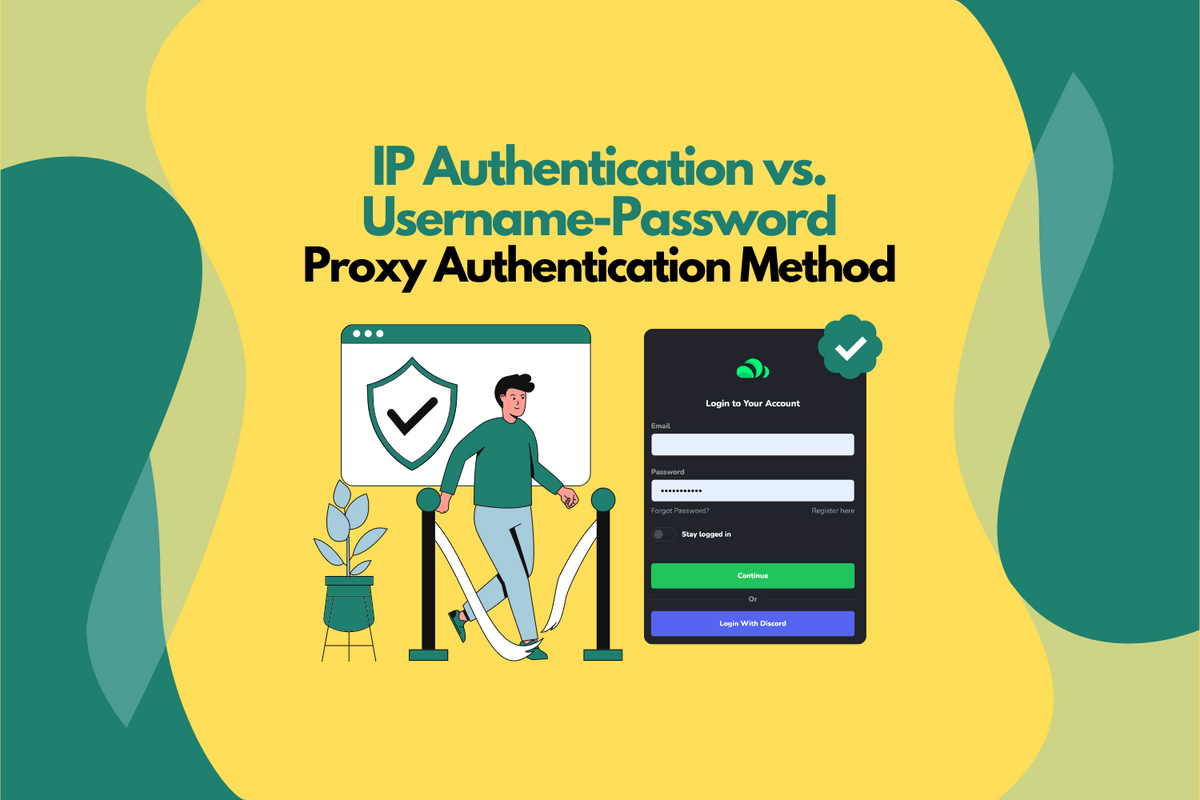
IP Authentication vs. Username-Password Proxy Authentication Method
|
|
Time to read 4 min
|
|
Time to read 4 min
| Key Takeaways |
|---|
| - Why Proxy Authentication is Important? |
| - What is Username-Password Authentication? |
| - How to Use Username-Password Authentication? |
| - Advantages and Disadvantages of Using Username and Password Authentication |
| - What is IP Authentication? |
| - How to Use IP Authentication Work? |
| - Advantages and Disadvantages of Using IP Authentication |
| - Choosing the Right Proxy Authentication Method |
Proxy servers, known as guardians of safe internet surfing, are now essential for both professionals and everyday users online. In fact, it is actually functioning as an intermediary between your device and the internet; this ensures a better level of privacy for you since they help in hiding your real IP.
But the effectiveness of proxies depends on how they verify users, sparking a debate between Username-Password authentication and IP authentication. Today we’ll break down these two proxy authentication methods, weigh their advantages and disadvantages and help you choose the best one for your internet needs.
The reason proxy authentication is so important is due to what it adds to our safety while online. In other terms, a private proxy IP, also called a personal proxy server, is the elite type of proxy that can serve only one user at a time. It is not shared with anybody, so you have full control of how and when to use it.
This brings in the process of proxy authentication. Proxy providers like ProxyHeaven offer their client's an authentication system for their proxies to assure the customer of such private proxy service and protect the customer and his bought proxies from any unauthorized user.
There are two primary methods of proxy authentication:
Both of these methods enhance your security, but there's still debate over which one is better, and we've compared them to assist you in selecting the ideal option for your needs.
For quite a long time, the classic combination of username and password has been the preferred choice for most internet users. This authentication method is widely used—from all kinds of social media platforms to e-mail, bank accounts, and so on. Perhaps you are already quite used to this kind of security measure.
The format looks like this: IP:PORT:USERNAME:PASSWORD
All that a user needs to do after the purchase is to input the IP address (which will be different for each proxy), port number, username, and password into their proxy settings, which are mostly made available from either the browser or in your software settings. With the method being just username and password-based, it makes it effortless for newcomers to use private proxies.
Note: When selecting a password, ensure it's as strong as possible. A good strategy is to use a mix of lowercase and uppercase letters, along with numbers and symbols.
One clear advantage is the control it gives the user. Having an option to change proxy passwords whenever needed, users can easily manage their security, which is especially important when using multiple proxies.
However, the strength of passwords can vary, and the threat of cyber-attacks makes this method relatively unsafe if not carefully managed. Precautions include not using the few and very known weak passwords like "password" and regularly updating to strong ones.
While having control is beneficial, managing multiple passwords can be challenging. It’s crucial to find the right balance between password complexity and memorability, as it often leads to password patterns or sacrificing security for convenience.
IP authentication works by using the IP address provided to you by your Internet Service Provider (ISP) to allow you access to your proxies. While it's not as common as using a username and password, it's still a secure proxy authentication method.
The format is as follows: IP:PORT.
Using IP authenticated proxies means there’s no need for a username and password; you will only need the IP and Port in your proxy settings. When you buy a proxy plan that offers IP authentication, you need to inform the provider of your IP address. This process, called whitelisting, ensures that only your IP address can access the proxy.
IP Authentication saves you from remembering very complex passwords or worrying about weak password security. Once you whitelist your computer's IP, you're good to go. Your proxy is automatically authenticated whenever you use your whitelisted IP.
However, IP authentication can be a bit of a problem in cases when your IP address frequently changes, like when you're often traveling or shifting between different networks. Since IP addresses vary by location, even if you whitelist multiple IPs, accessing your proxy from certain places—like a coffee shop where the IP isn't whitelisted—can be difficult.
Some ISPs provide static IPs that remain consistent, while others use dynamic IPs that change regularly for security reasons. While dynamic IPs enhance security by making it harder to hack, they require whitelisting each time they change, which complicates the process.
Proxy authentication methods are far from an one-size-fits-all solution, but selecting one that seamlessly integrates into your online routine while ensuring your safety is crucial. The choice between methods depends on your specific needs. If you're a beginner not seeking advanced protection, username and password authentication is suitable. Conversely, if you require professional-grade security and true anonymity online, IP authentication is the preferable option.
